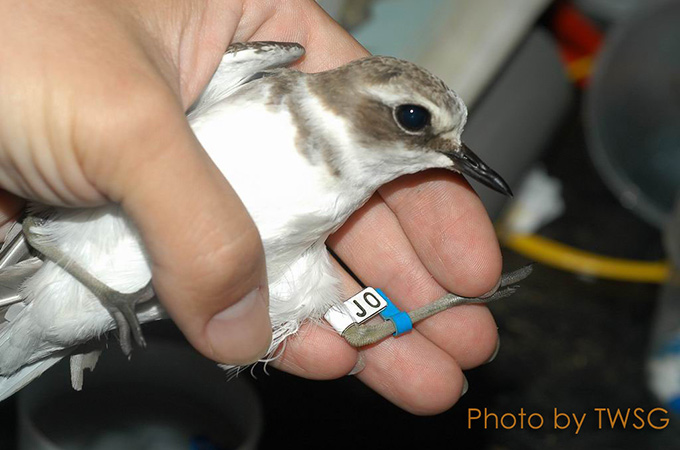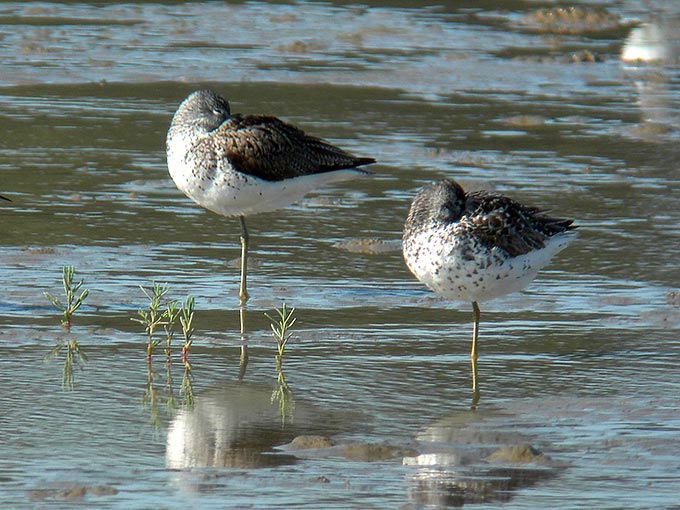This is a summary of count data (and habitat assessment) from the third of the four spring-tide cycles of the 2008 Saemangeum Shorebird Monitoring Program (SSMP), a joint initiative of the domestic organization Birds Korea and the international Australasian Wader Studies Group. The program was launched in 2006 to monitor the impacts of the 40,100 ha Saemangeum reclamation (i.e. wetland destruction) project on globally important populations of shorebirds supported by this estuarine system, already recognized as the most important known shorebird site in the Yellow Sea (Barter, 2002). These data will be analysed further, for publication in the SSMP 2008 Report and in other papers, and can be cited freely by others (with proper acknowledgement and caveats).
Following several days of exploratory surveys, a total of 23 people participated in dawn to dusk land- and boat-based survey work for the SSMP Third Count Cycle between May 7thth and 12th, covering the Geum Estuary, the Saemangeum area, and Gomso Bay (combined “The Study Site”). Experience over the past two years of the SSMP has indicated that this is the period in which numbers of most migratory shorebird species should peak in the study site. In addition to carrying out high tide counts at all the known shorebird roosts in these areas (repeating the counts at all of the major roosts), low tide counts were carried out through most of Saemangeum, as it was suspected that recent alterations in tidal flow (with tidal range increasing from c. 15 cm to almost 1.5 m) caused changes in the local movement patterns of shorebirds. Understanding these movements between roosts and feeding areas remains important to ensure that shorebirds are not double-counted or overlooked.
The Third Cycle count took place during a relatively long period of spring tides, with the highest tides at night outside of the Saemangeum reclamation area exceeding 7m. This was helpful for the surveys of the Geum Estuary and Gomso Bay, as the less elevated roosts were submerged, confining shorebirds to a small number of more elevated roosts where counts were reasonably straightforward. At both the Geum Estuary and Gomso Bay, high tide counts were also repeated on lower tides (c. 6 m) to assess the effect of tide height on numbers observed. In Saemangeum the effects of the large tidal amplitude were less predictable. Through the 2007 surveys, only one or two of the sluices of the gates in the Saemangeum sea-wall had been left open, resulting in a tidal range within Saemangeum of only a few centimeters. During early May more sluices were open (including four out of seven sluices in the southern sea-gate) and in combination with the large tidal amplitude in this tide series, tidal range within Saemangeum exceeded 1.3 m, with high tides peaking 2-3 hours after the peak of high tide outside the sea-wall. These high tides pushed birds off island tidal flats in the outer Saemangeum system to mainland roosts, and also made some tidal flats of the inner Mangyeung and Dongjin estuaries suitable for feeding shorebirds at low tide. The more elevated regions of inner Saemangeum (which had been tidal flats until 2006) remained unsuitable for shorebirds, as they have been overgrown by saltmarsh vegetation over the past two years, so at high tides birds feeding in the inner Saemangeum were forced to a small number of mainland roosts, notably at Okgu, Simpo, and on the shores opposite the Gunsan air-base. At low tide the increased tidal range in Saemangeum exposed mudflat areas that were sub-tidal through most of 2007 and 2008. However these newly exposed tidal flats were probably rather depleted of potential prey, as there had been a massive shellfish die-off on the lower flats in late April 2008, coinciding with a temporary draw-down of water levels within the Saemangeum system.


Photo © Chung-Yu Chiang (Taiwan Wader Studies Group)
In total, 147,088 shorebirds were counted during this count period, with 97,640 in the Geum Estuary, 34,274 within the Saemangeum reclamation area (the vast majority in the outer parts of the system), and 9,861 at Gomso Bay. These compare to SSMP counts during the Third Count Cycle period in 2007 (May 15th-19th) of 93,342 shorebirds at the Geum Estuary, 54,771 shorebirds within Saemangeum, and 726 at Gomso Bay – numbers already significantly reduced when compared to the same period in 2006.
Within the SSMP study site, Dunlin Calidris alpina (75,557) was much the most numerous species (compared to whole study site counts during northward migration in 2006 and 2007 of 85,987 and 71,365 respectively), followed by Great Knot Calidris tenuirostris (21,539, compared to whole study site counts during northward migration in 2006 and 2007 of 116,139 and 83,350 respectively), Bar-tailed Godwit Limosa lapponica (16,259), Grey Plover Pluvialis squatarola (5,912), Terek Sandpiper Xenus cinereus (5,539), Mongolian Plover Charadrius mongolus (5,288) and Red-necked Stint Calidris ruficollis (4,727).
At the Geum Estuary, eight shorebird species were recorded in Ramsar Convention-defined internationally important concentrations (i.e. 1% or more of population), based on Wetlands International (2006). Dunlin were found in unprecedented numbers for this site, with a total of 53,565 birds occurring almost entirely in a single roosting flock at Yubu Island. This might reflect displacement of birds from Saemangeum, as the combined Dunlin totals found in Saemangeum and the Geum Estuary in 2008 were similar to those recorded in 2006. Another highlight in the Geum Estuary was the number of the Endangered Nordmann’s Greenshank Tringa guttifer, with the minimum count of 56 birds comprising 7% of the global population; there were also a minimum of 8 Spoon-billed Sandpiper, at least 1% of the world population of this now Critically Endangered species. Great Knot (13,780) had declined markedly compared to the corresponding period in 2007 (36,252) but were still present in internationally significant numbers (3.6% of the flyway/global population), as were Eastern Oystercatcher Haemaptopus (ostralegus) osculans (5%), Grey Plover (3%), Bar-tailed Godwit (7% of combined totals of baueri and menzbieri subspecies), Eurasian Curlew Numenius arquata orientalis (2%), Far Eastern Curlew (7%). In addition, eight Black-faced Spoonbill Platelea minor (Endangered) and 20 Saunders’s Gull Larus saundersi (Vulnerable) were also logged during the count period. A parallel survey of all major shorebird sites in South Korea between May 2nd and May 13th, conducted by Birds Korea with essential support from the AWSG, has confirmed that the Geum Estuary is now by far the most important shorebird site remaining in the country, and one of the most important in the East Asian – Australasian Flyway. It has recently survived a reclamation threat, but being a small area close to a large industrial city, it is far from secure. Ramsar listing for this site would be highly desirable.

Photo © Chung-Yu Chiang and Husan Hao Chen (Taiwan Wader Studies Group)
Counts within the Saemangeum reclamation area demonstrated a huge decline in Great Knot numbers, with only 2,769 birds feeding in the reclamation area (c.f. 8,169 in 2007, and 83,404 in 2006 before reclamation began to take effect on this species). A further c.5,000 Great Knot fed on tidal flats just outside the southern base of the Saemangeum sea-wall, and c. 2000 of these moved into Saemangeum briefly during high tide periods, perhaps taking advantage of the later times of high tide within Saemangeum to spend 1-2 hours extra feeding on tidal flats as the tide rose. However, it is unlikely that this is a major foraging area for them, given that c. 3,000 Great Knot from the same feeding areas near the sea-wall roosted in Gomso Bay (c. 15km away) in preference to Saemangeum (c. 1km away). Some 3,000 Dunlin also fed just outside the sea-wall, most at high tide joining the 15,699 Dunlin that routinely fed in Saemangeum. Five shorebird species were again found in Ramsar Convention-defined internationally important concentrations (as described above): osculans Eastern Oystercatcher (1%), Grey Plover (1-2%), Bar-tailed Godwit (1% of combined totals of baueri and menzbieri subspecies), Great Knot (3%) and Dunlin (1% of combined total of sakhalina and articola). In addition, seven Black-faced Spoonbill, two Chinese Egret Egretta eulophotes and five Saunders’s Gull were recorded during the count period. Clearly, while much degraded (and already supporting significantly reduced numbers of shorebirds), the Saemangeum reclamation area remains an internationally important wetland for waterbirds. Restoration of an increased and regular tidal-flow would greatly reduce the impacts on shorebirds caused by this massive loss and degradation of habitat.
Higher shorebird numbers (reaching 9,980 on one date) were recorded in Gomso Bay than ever before. These counts included c. 2,000 Great Knot and c. 1,000 Dunlin that did not actually feed in Gomso Bay (except perhaps briefly on the ebbing tide), instead flying into the bay to roost when high tide drove them from core feeding areas on the tidal flats immediately south-west of the Saemangeum sea-wall. Nevertheless, some 5,000 to 7,000 shorebirds appeared to be using Gomso Bay as a feeding area as well as a roosting area, and these included internationally important numbers of 1686 Whimbrel Numenius phaeopus (c. 3% of the flyway population), 615 Terek Sandpiper (c. 1% of the flyway population), and near-significant numbers of 2,966 Great Knot and 3,127 Dunlin.
In parallel to the counts, extensive searches were made for leg-flagged and individually colour-banded birds. These searches were unusually intensive (in part due to the presence of two dedicated flag and band researchers from the Global Flyway Network), and have generated such a volume of resightings that we have not yet been able to enter all of the data. However, the sightings confirm that the region is used intensively by migratory birds from non-breeding areas in Australia, New Zealand, and Thailand; from staging areas which include Taiwan and the Shanghai region; and from breeding grounds as far away as Alaska. One especially noteworthy find was a uniquely marked breeding Kentish Plover Charadrius alexandrinus in the Saemangeum reclamation area that had been banded in the non-breeding season in Taiwan.
Preparations for the fourth and final count cycle (planned for May 19th-25th) are now under way.
Our thanks to all who continue to support this extremely important project.
SSMP Team, Iksan, May 15th, 2008.
References
- Barter, M.A. 2002. Shorebirds and The Yellow Sea: Importance, threats and conservation status. Wetlands International Global Series 9, International Wader Studies 12, Canberra, Australia.
- Wetlands International. 2006. Waterbird Population Estimates – Fourth Edition. Wetlands International, Wangeningen, The Netherlands



